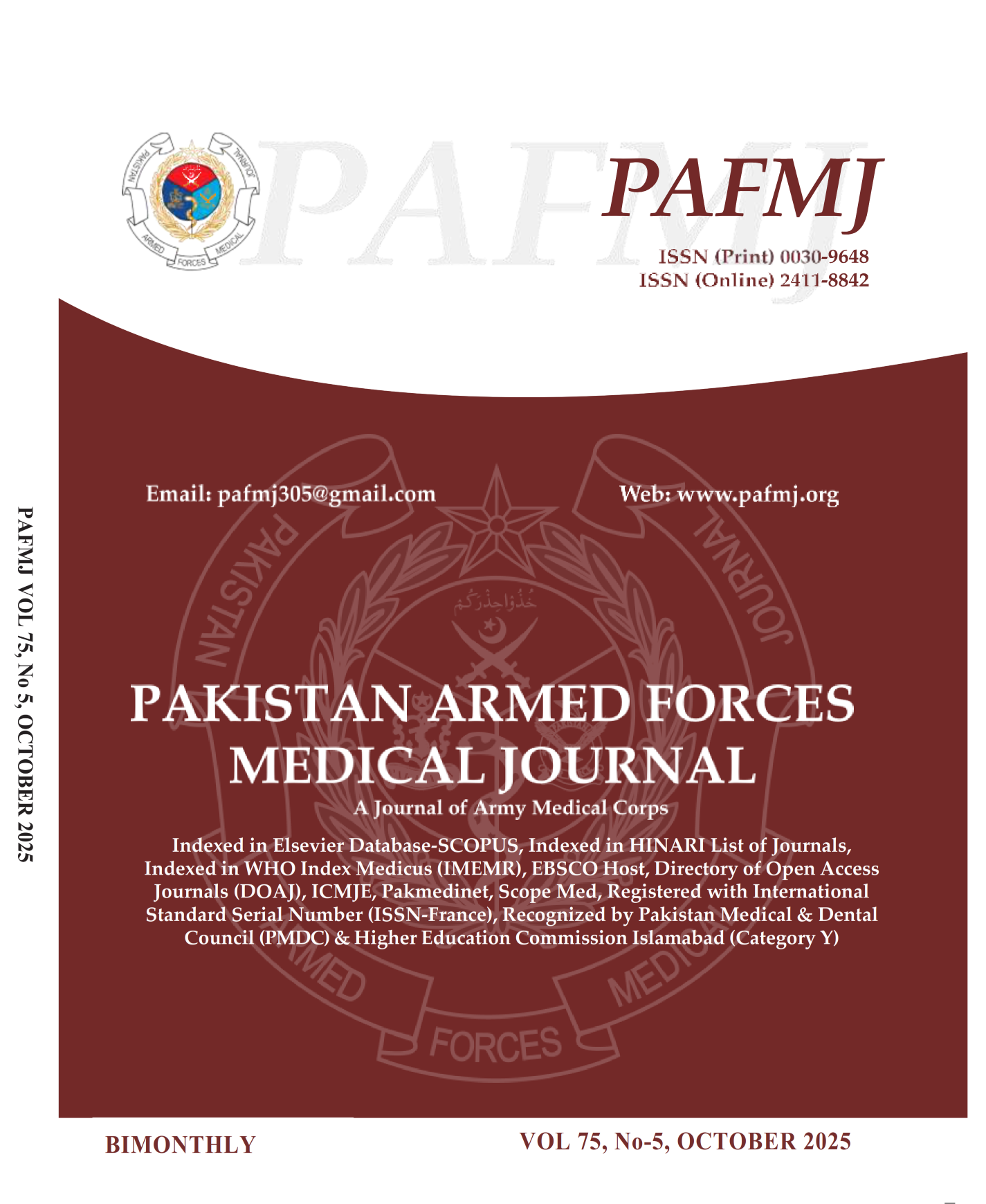Diagnostic Accuracy of Tc99m-Sestamibi in Differentiating Benign vs Malignant Renal Masses
DOI:
https://doi.org/10.51253/pafmj.v75i5.10913Keywords:
Oncocytoma, Renal Cell Carcinoma, SPECT/CT, Tc-99m SestamibiAbstract
Objective: To assess the role of pre-operative Tc-99m sestamibi scintigraphy in Differentiating Benign vs Malignant Renal Masses.
Study Design: Cross-sectional study
Place and Duration of Study: Nuclear Medical Centre, Armed Forces Institute of Pathology, Rawalpindi Pakistan, from Jun 2022 to Jun 2023.
Methodology: A total of 41 patients with T1 solid renal tumours who were eligible for undergoing surgery or suitable for biopsy underwent Tc-99m sestamibi scintigraphy during study duration. Tc-99m sestamibi scintigraphy findings were correlated with post-operative histopathology results to determine accuracy of scintigraphic study.
Results: Out of forty-one patients, 24(58.5%) were men and 17(41.5%) were women with a mean age 54.39±13.28 years. Among total patients, 24(58.5%) had clear cell RCC, 5(12.2%) had papillary RCC, 3(7.3%) had chromophobe RCC, 2(4.9%) had oncocytic papillary RCC, 5(12.2%) had oncocytoma and 2(4.9%) had lipid poor angiomyolipoma variant on histopathology. Overall, 7(17.07%) patients had benign pathology. Tc-99m Sestamibi SPECT/CT correctly identified all benign lesions (oncocytoma and lipid poor angiomyolipoma) and two variants of malignant pathology (chromophobe and oncocytic papillary RCC) yielding a sensitivity of 100% while specificity of 85.29% in detecting benign lesions. There was significant correlation between positive Tc-99m sestamibi findings and benign pathology with a p-value <0.001.
Conclusions: Tc-99m sestamibi scintigraphy plays a significant role in pre-operative evaluation of renal masses and offers a non-invasive modality to help differentiate benign and malignant renal masses.
Downloads
References
1. Padala SA, Barsouk A, Thandra KC, Saginala K, Mohammed A, Vakiti A, et al. Epidemiology of renal cell carcinoma. World J Oncol 2020;11(3):79-87.
https://doi.org/10.14740/wjon1279
2. Capitanio U, Bensalah K, Bex A, Boorjian SA, Bray F, Coleman J, et al. Epidemiology of renal cell carcinoma. Eur Urol 2019; 75(1): 74-84. https://doi.org/10.1016/j.eururo.2018.08.036
3. Nakata K, Colombet M, Stiller CA, Pritchard‐Jones K, Steliarova‐Foucher E, IICC‐3 contributors. Incidence of childhood renal tumours: an international population‐based study. Int J Cancer 2020; 147(12): 3313-3127.
https://doi.org/10.1002/ijc.33147
4. Tsili AC, Andriotis E, Gkeli MG, Krokidis M, Stasinopoulou M, Varkarakis IM, et al. The role of imaging in the management of renal masses. Eur J radiol 2021; 141: 109777.
https://doi.org/10.1016/j.ejrad.2021.109777
5. Ljungberg B, Albiges L, Abu-Ghanem Y, Bedke J, Capitanio U, Dabestani S, et al. European Association of Urology Guidelines on Renal Cell Carcinoma: The 2022 Update. Eur Urol 2022; 82(4): 399-410. https://doi.org/10.1016/j.eururo.2022.03.006
6. Schieda N, Krishna S, Pedrosa I, Kaffenberger SD, Davenport MS, Silverman SG. Active surveillance of renal masses: the role of radiology. Radiol 2022; 302(1): 11-24.
https://doi.org/10.1148/radiol.2021204227
7. Asi T, Tuncali MÇ, Tuncel M, Alkanat NEİ, Hazir B, Kösemehmetoğlu K, et al. The role of Tc-99m MIBI scintigraphy in clinical T1 renal mass assessment: Does it have a real benefit? Urol Oncol 2020; 38(12): 937.
https://doi.org/10.1016/j.urolonc.2020.07.018
8. Posielski NM, Bui A, Wells SA, Best SL, Gettle LM, Ziemlewicz TJ, et al. Risk factors for complications and nondiagnostic results following 1,155 consecutive percutaneous core renal mass biopsies. J Urol 2019; 201(6): 1080-1087.
https://doi.org/10.1097/ju.0000000000000113
9. Bakdash K, Schramm KM, Annam A, Brown M, Kondo K, Lindquist JD. Complications of Percutaneous Renal Biopsy. Semin Intervent Radiol 2019; 36(2): 97-103.
https://doi.org/10.1055/s-0039-1688422
10. Zhu H, Yang B, Dong A, Ye H, Cheng C, Pan G, et al. Dual-phase 99mTc-MIBI SPECT/CT in the characterization of enhancing solid renal tumors: a single-institution study of 147 cases. Clin Nucl Med 2020; 45(10): 765-770.
https://doi.org/10.1097/rlu.0000000000003212
11. Cooper S, Flood TA, Khodary ME, Shabana WM, Papadatos D, Lavallee LT, et al. Diagnostic yield and complication rate in percutaneous needle biopsy of renal hilar masses with comparison with renal cortical mass biopsies in a cohort of 195 patients. Am J Roentgenol 2019; 212(3): 570-575.
https://doi.org/10.2214/ajr.18.20221
12. Wilson MP, Katlariwala P, Abele J, Low G. A review of 99mTc-sestamibi SPECT/CT for renal oncocytomas: A modified diagnostic algorithm. Intractable Rare Dis Res 2022; 11(2): 46-51.
https://doi.org/10.5582/irdr.2022.01027
13. Tzortzakakis A, Gustafsson O, Karlsson M, Ekström-Ehn L, Ghaffarpour R, Axelsson R. Visual evaluation and differentiation of renal oncocytomas from renal cell carcinomas by means of 99mTc-sestamibi SPECT/CT. EJNMMI Res 2017; 7(1): 1-5.
https://doi.org/10.1186/s13550-017-0278-z
14. Tzortzakakis A. Differentiation of Renal Oncocytoma from Renal Cell Carcinoma by Means of 99M TC-Sestamibi SPECT/CT (Doctoral dissertation, Karolinska Institute (Sweden)).
https://doi.org/10.21203/rs.3.rs-446272/v1
15. Rowe SP, Gorin MA, Solnes LB, Ball MW, Choudhary A, Pierorazio PM, et al. Correlation of 99mTc-sestamibi uptake in renal masses with mitochondrial content and multi-drug resistance pump expression. EJNMMI res 2017; 7(1): 1-7.
https://doi.org/10.1186/s13550-017-0329-5
16. Sistani G, Bjazevic J, Kassam Z, Romsa J, Pautler S. The value of 99mTc-sestamibi single-photon emission computed tomography-computed tomography in the evaluation and risk stratification of renal masses. Can Urol Assoc J 2021; 15(6): 197.
https://doi.org/10.5489/cuaj.6708
17. Gorin MA, Rowe SP, Baras AS, Solnes LB, Ball MW, Pierorazio PM, et al. Prospective evaluation of 99mTc-sestamibi SPECT/CT for the diagnosis of renal oncocytomas and hybrid oncocytic/chromophobe tumors. Eur Urol 2016; 69(3): 413-436.
https://doi.org/10.1016/j.eururo.2015.08.056
18. Jones KM, Solnes LB, Rowe SP, Gorin MA, Sheikhbahaei S, Fung G, et al. Use of quantitative SPECT/CT reconstruction in 99mTc-sestamibi imaging of patients with renal masses. Ann Nucl Med 2018; 32(2): 87-93.
Downloads
Published
Issue
Section
License
Copyright (c) 2025 Zeeshan Sikandar, Fida Hussain, Zaigham Salim Dar, Rebecca Sharoon, Aleena Tariq, Muhammad Usman Ibrahim

This work is licensed under a Creative Commons Attribution-NonCommercial 4.0 International License.















